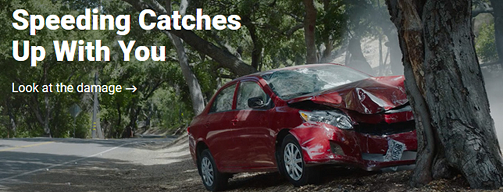Aggressive driving is any unsafe behavior performed purposely with ill intent or disregard for safety that puts other drivers or property at risk. It is a moving violation subject to fines or jail time. Examples of aggressive driving include:
- speeding in heavy traffic and/or driving too fast for road conditions;
- tailgating and/or cutting in front of another driver, then slowing down;
- running red lights, speeding up through yellow lights or running stop signs (most dangerous);
- weaving in and out of traffic and changing lanes without signaling;
- blocking cars attempting to pass or change lanes; or
- passing a vehicle on the wrong side of the road.
Some people drive aggressively because they have too much to do and are “running late” for work, school, their next meeting, lesson, soccer game, or other appointment.
Speeding is a type of aggressive driving that often includes many other unsafe behaviors including: tailgating, frequent unsafe lane changes, running red lights or stop signs, and often become angry at anyone who they believe impedes their progress.
Speed also affects your safety even when you are driving at the speed limit but too fast for road conditions, such as during bad weather, during traffic congestion when a road is under repair, or in an area at night that isn’t well lit.
Speeding endangers not only the life of the speeder, but all of the people on the road around them, including law enforcement officers. In 2020, speeding was a contributing factor in 29% of all traffic fatalities.

Extreme cases of aggressive driving escalate to road rage, which can end in violence. Road rage behaviors (other than shouting or inappropriate gesturing) is a criminal offense. Examples of road rage include any of the following behaviors:
- cursing or making rude or obscene gestures at other drivers;
- throwing objects at another vehicle;
- ramming or sideswiping a vehicle;
- forcing a driver off the road; or
- physically assaulting a driver.
Once you’ve identified an aggressive driver, the safest thing that you can do is to avoid them.
Use your mirrors and peripheral vision to actively monitor the area around your vehicle. When you see a vehicle being driven aggressively make a mental note of the vehicle and its position. Stay alert to the likelihood that driver may create hazards that you’ll need to deal with.
When you see an aggressive driver, make your avoidance plan. Most often, the best solution is to let them go ahead. Find a safe place, adjust your lane position a little so they can see the way past you is clear. You may want to gently reduce your speed to encourage them to pass.
Avoid Confrontation
Remaining calm and courteous behind the wheel of a vehicle lowers a driver’s risk of an unpleasant confrontation or negative driving encounter.

Avoid eye contact. Eye contact with aggressive drivers increases the chance of confrontation. Steer clear and ignore angry drivers, when possible. Keep the encounter as impersonal as possible.
Do not respond to aggression with aggression.
Traffic problems and drivers’ behaviors are not a personal challenge or an affront. Avoid becoming reactive. Get out of the other drivers’ way as soon as safely possible.
Be tolerant and forgiving. Another driver may be having a really bad day. Always assume their behavior is not personal.
While drivers have no control over others on the road, they can control their behaviors and reactions to circumstances around them. Staying alert, remaining calm, and obeying the rules of the road can help decrease aggressive driving and avoid the dangers of road rage.
Avoid Actions that Provoke Others
Avoid tailgating.
Give other drivers room on the road. Leave at least a two-second cushion between vehicles to provide enough room to stop in an emergency and to give other drivers room to change lanes, if needed. Having a safety zone of at least two seconds between your car and the next vehicle is recommended during normal driving conditions. Bad weather, traffic conditions, and personal preferences could all require the safety zone to be larger.
Never drive in the passing lane.
The left lane of multi-lane roadways is the passing lane for use when passing another vehicle. After passing a vehicle, move back into a driving lane when both headlights of the passed vehicle are visible in the rear view mirror.
Let drivers pass.
Avoid obstructing the flow of traffic even when going the speed limit. Always allow faster traffic to pass. Never challenge an aggressive driver by speeding up, slowing down, or attempting to hold the same position. Avoid causing another driver to change their speed or direction. Never force a driver to use their brakes or turn their steering wheel.
Use turn signals appropriately.
Use turn signals when merging, changing lanes, or turning. Check blind spots before merging or switching lanes to ensure other drivers are not cut off. Do not speed. Speeding increases the chances of a driver losing control of a vehicle. It is a contributing factor in more than one-quarter of all traffic fatalities.
Use the horn and headlight high beams responsibly.
Tap the horn only when needed but avoid the long blasts and accompanying hand gestures. On an expressway, two brief flashes of high beams are acceptable to request a slow driver in a passing lane to move. Do not use repeated high beam flashes or use steady high beams to make a slow vehicle move or go faster. When driving at night, dim headlights when approaching head-on traffic.
Let drivers merge.
Whether merging or yielding the right of way, drive courteously to avoid a confrontation. When in doubt let, the other vehicle go first.
Consider others in parking lots.
Park in one spot, not across multiple spaces. Take care not to hit cars with the
vehicle’s door or with nearby shopping carts.
How to Avoid Becoming an Aggressive Driver
Make a plan and give yourself enough time to get where you are going. Not knowing where you’re going or not having enough time to get there are among the most common reasons for aggressive driving behaviors. Avoid those traps: think about the route you’re going to take and make a trip plan with a realistic schedule. Make adjustments when trips don’t proceed exactly as planned. Don’t take your problems and frustrations with you into the car. Getting behind the wheel when you’re upset, frustrated or angry can be an invitation to poor driving behaviors. Remember speed limits are put in place to protect all road users.
Sources:
https://www.nhtsa.gov/risky-driving/speeding
https://www.tdi.texas.gov/pubs/videoresource/fsaggressive.pdf
https://www.thesilverlining.com/westbendcares/blog/eight-signs-youre-an-aggressive-driver
